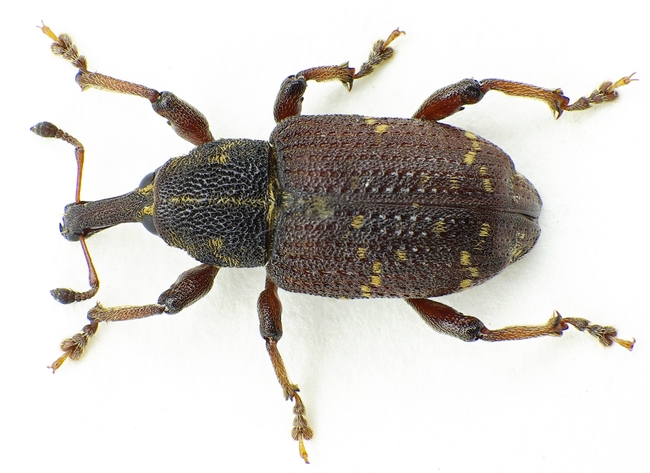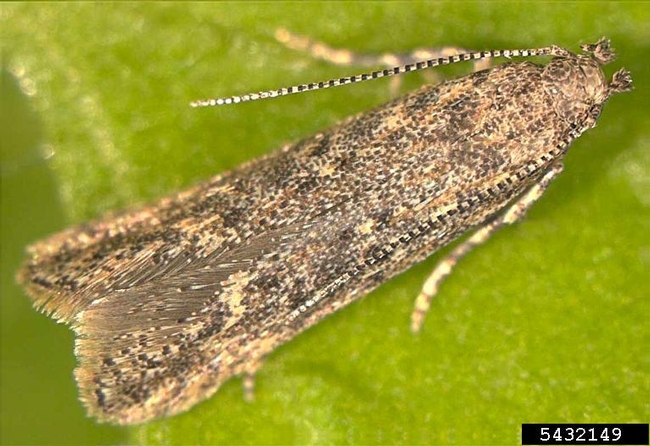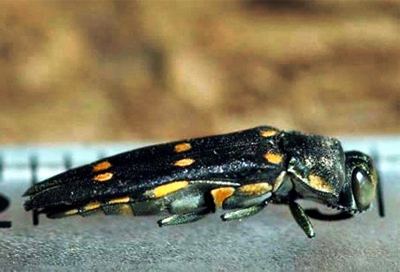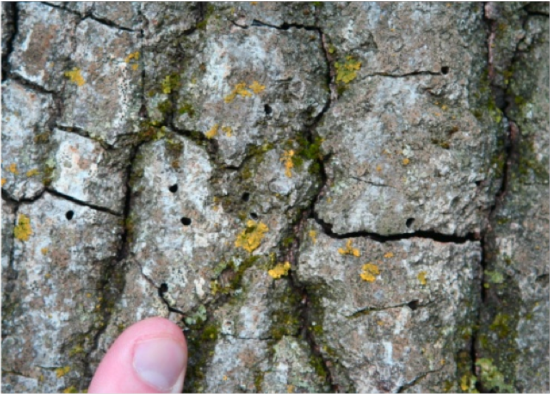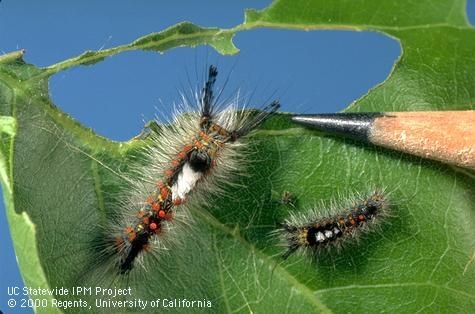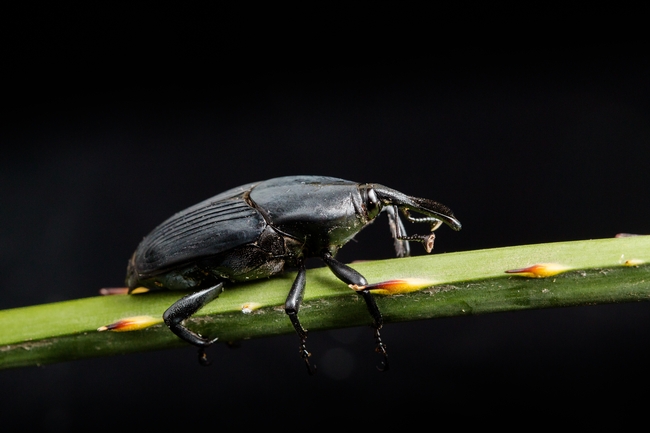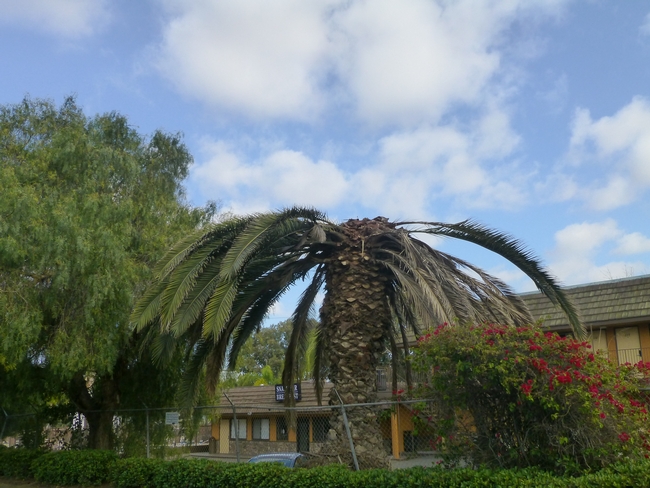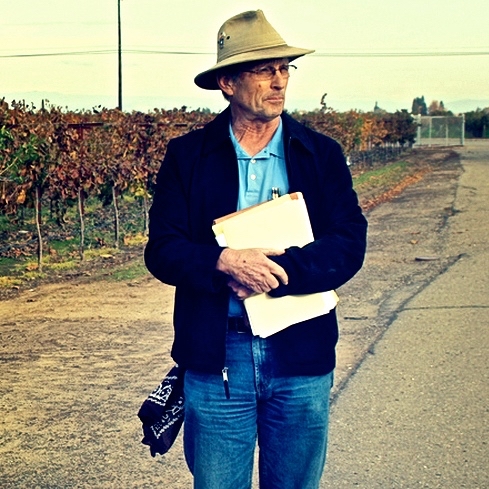Posts Tagged: Mark Hoddle
Three UC ANR programs receive research grants from CDFA
The California Department of Food and Agriculture has awarded more than $1 million to fund three UC Agriculture and Natural Resources integrated pest management projects to research insects that have the potential to become pests in California agriculture. Each of the three-year projects received strong support from commodities which could be affected by invasive pests.
The projects that were awarded the funds are:
Proactive management of avocado seed and stem feeding weevils, led by UC Cooperative Extension specialist Mark Hoddle and entomology professor Jocelyn Millar, both at UC Riverside, will receive $348,893. This project will develop pheromones, identify natural enemies in the host range, and quantify flight capacity of the avocado seed weevils. Native to Mexico and invasive in Ecuador, these weevils feed directly on avocados and could cause substantial damage to the California avocado industry. The California Avocado Commission pledged an additional $150,000 to support this project. The work will be conducted at UC Riverside and in Mexico.
A proactive approach to prepare for the invasion of Tuta absoluta into California, led by UCCE specialist Ian Grettenberger, will receive $499,847. T. absoluta, a tomato leafminer, is a serious pest throughout Europe, Africa, western Asia and South and Central America and could decimate California's tomato industry. This project will proactively test targeted insecticides, identify native natural enemies that could be used in biological control, and conduct work to assist in breeding plants resistant to this pest. This project will be conducted at UC Davis, throughout California, and in Chile and Peru.
Detection, biology and control of the exotic Sweede midge for California cole crops, led by UCCE area IPM advisor Alejandro Del Pozo-Valdivia, UCCE specialist Ian Grettenberger and USDA research entomologist Daniel Hasegawa. Swede midge is a pest of cole crops in the Northeastern U.S. and Canada and could cause significant management issues for California's large cole crop industry. This project will collect important information about the biology of Swede midge, test low impact insecticides and botanical products as options for control, assess the possibility of weeds as alternative hosts, and work with growers to start monitoring for the pest. This project will be conducted at UC Davis and in the Salinas Valley.
Goldspotted oak borer continues to spread
The invasive beetle, goldspotted oak borer (GSOB), has been found in the mountain community of Sugarloaf near Big Bear in San Bernardino County, reported the Chino Champion. The detection causes concern for other nearby communities where oak trees are prized.
All stages of the insect - larval, pupal and adult - were found underneath bark in dying black oak trees on private property. GSOB is a native of Guatemala, southern Mexico and southeastern Arizona. It was first collected in San Diego County in 2004. To limit the pest's spread, officials ask Californians not to transport firewood from one location to another.
"It realistically should be treated like a quarantine situation," said Doug Yanega of the UC Riverside Department of Entomology. "All it takes is a few people who don't know any better or think the rules don't apply to them to infest new areas."
The Chino Hills area has nearly 4,000 oak trees in parks, landscaping and parkways, not including trees on private property and city open space.
"The goldspotted oak borer posts an unprecedented threat to native oaks in Southern California," said UC Cooperative Extension specialist Mark Hoddle, director of the the Center for Invasive Species Research at UC Riverside. "Hiking trails and campsites have been closed because of the risk of branches dropping from dead trees."
For more information about GSOB, see the UC Cooperative Extension GSOB website.
ANR in the news April 19-30
CDFA awards grant for Proactive IPM program
(Morning Ag Clips) April 30
The California Department of Food and Agriculture has awarded funding for one project in the initial funding cycle for the Proactive Integrated Pest Management (IPM) Solutions grant program. The project, titled “Proactive Biological Control of Spotted Lantern Fly, Lycorma delicatula (Hemiptera: Fulgoridae)” was awarded $543,936.
The three-year project will develop biological control agents for spotted lantern fly, an invasive pest that has not yet arrived in California but is spreading rapidly across the eastern US. This pest has the potential to affect many high-value California crops including grapes, walnuts, avocados, and pistachios. The project will piggyback on work that is already being conducted on the pest in the eastern US and abroad. Project leads are Dr. Mark Hoddle (UC Riverside) and Dr. Kent Daane (UC Berkeley). The biological control agent is a small (3 mm) stingless wasp, native to China, that parasitizes the eggs of the spotted lantern fly.
https://www.morningagclips.com/cdfa-awards-grant-for-proactive-ipm-program
Learn about sheep, shearing, and more at Barn to Yarn in Hopland this week
(MendoVoice) April 30
If you've ever wondered how a sheep's wool becomes a sweater, you might want to check out the "Barn to Yarn" event in Hopland this weekend. This popular springtime event will return to the University of California Hopland Research and Extension Center this Saturday, May 4.
The Barn to Yarn event will feature farmers and ranches, shearers, spinners, weavers, and knitters, and other local experts involved in the Northern California sheep industry. There will educational activities, presentations, workshops, take-home craft activities, and more for all ages.
Moth caterpillars are back for a rare second bite in the Bay Area
(Mercury News) Cat Ferguson, April 29
…Andrew Sutherland, University of California Cooperative Extension's urban integrated pest management adviser for the Bay Area, recommends a simple preventive measure: reach for the hose.
Right after the bugs have hatched, “use pressure washers to push the larvae off the trees before they start wandering around,” he said. “In the late summer and fall, if you've got egg masses, you can wash them off and you won't have an issue next year on that tree.”
Bay Area pest control and horticulture experts say most caterpillar calls come from Santa Clara and southern San Mateo counties, which Sutherland linked to warm weather and high densities of host plants — the caterpillars are particularly fond of oak and fruit trees. Sutherland said he doesn't field nearly as many calls from the East Bay.
https://www.mercurynews.com/2019/04/29/san-jose-moth-boom/
Hopland Research Center holds BioBlitz for Mendocino County students
(Ukiah Daily Journal) Curtis Driscoll, April 26
The Hopland Research and Extension Center held its annual “BioBlitz” on Friday for over 200 students from across Mendocino County, giving them a chance to explore their interest in science by finding new species at the Hopland Research Site.
The BioBlitz went on at the same time as the 2019 City Nature Challenge, an international event where people find and document plants and wildlife in cities across the globe. Although students in Mendocino County couldn't participate in the national event, the Hopland Research Center decided to have the BioBlitz as a way to allow students to explore nature in Mendocino County.
…Experts also helped the students learn more about the area in Mendocino County and the many kinds of unique species that are in the county. Anna Holmquist, an arachnologist from UC Berkeley, entomology students from UC Berkeley, and California Naturalists, people who have gone through a UC naturalist training program, were all available throughout the day to help students and guide them as they made different discoveries.
“We will be looking for species with them and searching and trying to add to the list, but there will be a bit more depth to it with the kids actually trying to build on their understand of our Mendocino habitats,” said Hopland Research Center Community Educator Hannah Bird.
Have the Tough Conversations: Koopmann Family Ranch Transfer
(Capital Press) Ashley Rood, April 26
… The next generation of Koopmanns, Carissa and Clayton, are well-poised to continue the family legacy of conservation and ranching. Both are building up their own cow herds on leased land while, as partners in the family LCC, they help make the big decisions. They also have full-time agriculture jobs off the ranch focused on grazing. Clayton is the range manager for the local water utility, the SFPUC, and has a grazing management consulting business. Carissa is a livestock and natural resources advisor for University of California Cooperative Extension in Siskiyou County. Both Carissa and Clayton emphasize how hard it is to make a living ranching alone, even with all the advantages of the family ranch. But getting out on the land, despite the hard work, is a place of relaxation for both of them.
For others considering succession planning, Carissa says, “Get started early and don't ever make assumptions. It's vital to know what everybody truly wants. Ultimately, the end goal that is that you're still a family, regardless of what happens.”
Fresh, local and sustainable advice
(Marin Independent Journal) Jane Scurich, April 26
Ah, spring! Time to visit the local farmers market for tender locally grown asparagus, luscious spring peas and great gardening advice. Wait — what's that last item — advice? Yes — and it's free!
Knowledgeable, UC-trained volunteers in the University of California Marin Master Gardener program officially open their market advice tables in May to provide research-based information on horticulture and sustainable gardening practices to Marin residents.
https://www.marinij.com/2019/04/26/fresh-local-and-sustainable-advice/
Love science? Free app allows you to assist in research!
(ABC10) Monica Woods, April 25
…In the words of Laci Gerhart-Barley, iNaturalist is "Instagram for biology and nature enthusiasts." The professor with the biological services department at the University of California, Davis, is even incorporating it into her classroom.
… Each year iNaturalist users participate in a "competition" to see what region can upload the most photos in the matter of a few days. The City Nature Challenge started as a competition between the California Academy of Sciences in San Francisco and the Los Angeles County Natural History Museum and gradually grew to include regions all over the world.
The Sacramento region is getting on board for the first time in 2019. [Sarah Angulo, community education specialist for the California Naturalist Program, is helping organize the challenge.]
The City Nature Challenge Sacramento will take place from Friday, April 26 to Monday, April 29.
UC Extension head updates supervisors on programs and leaders
(Plumas News) Victoria Metcalf, April 24
The face of the Farm Advisor's office is changing.
Plumas and Sierra county Farm Advisor Director David Lile was before the Plumas County Board of Supervisors April 9, explaining just how much his staff has changed.
… Holding up a copy of the local University of California Agriculture and Natural Resources annual report for last year, Lile said, It's “easy to look at with plenty of pictures.”
…Lile then introduced Ryan Tompkins as the new forestry advisor. He replaces longtime representative Mike DeLasaux who retired in 2018.
…Natural resources and livestock liaison with local ranchers was introduced next. That's Tracy Scholr [Schohr].
…Most 4-H members and their parents already know 4-H Program Representative Kari O'Reilly.
… Tom Getts was also introduced as the technical assistance for Plumas and Sierra farmers and Susanville area land managers.
… And Barbara Goulet, as administrative assistant, provides support to the staff, but also works with local Master Gardener volunteers and 4-H volunteers, according to Lile.
http://www.plumasnews.com/uc-extension-head-updates-supervisors-on-programs-and-leaders/
Can California get cows to burp less methane?
(NBC News) April 24
California is now requiring the beef and dairy industry to reduce its greenhouse gas emissions. Some scientists are testing and growing a red algae seaweed that can reduce methane from cow burps.
https://www.nbcnews.com/leftfield/video/can-california-get-cows-to-burp-less-methane-1506967107599
How to Control Thrips in Blueberries
(California Fresh Fruit) Matthew Malcolm, April 24
Citrus thrips have been a major nuisance for California blueberry growers, but how do you keep them under control and when should you apply crop protection materials? Is there an organic treatment available? Watch this brief interview UC Cooperative Extension Farm Advisor David Haviland as he answers all these questions. Read more about blueberry pest management in California Fresh Fruit Magazine.
https://calfreshfruit.com/2019/04/24/how-to-control-thrips-in-blueberries/
UC: Older vineyards can be modified for mechanization
(Ag Alert) April 24
Saying they have proven that older vineyards can be converted to mechanization, University of California Cooperative Extension specialists say winegrape growers in the San Joaquin Valley do not have to replant vineyards if they want to switch to mechanical pruning.
Growers who want to make the switch can retrain the vines to make the transition, without losing fruit yield or quality, according to a UCCE study.
UCCE specialist Kaan Kurtural said the study found that "growers do not have to plant a new vineyard to mechanize their operations."
"We have proven beyond a doubt that an older vineyard can be converted to mechanization," he said.
There is no loss in yield during conversion, Kurtural said, "and post-conversion yield is better and fruit quality is equivalent to or better than hand-managed vines."
http://agalert.com/story/?id=12932
No replanting needed for mechanical pruning
(Farm Press) Tim Hearden, April 24
University of California (UC) researcher Kaan Kurtural has gained recognition in recent years for automating a vineyard operation in the Napa Valley, which was planted at a density conducive to the practice.
Now Kurtural and other UC Cooperative Extension scientists are applying their knowledge in the San Joaquin Valley, where they say growers who wish to switch from hand to mechanical pruning to save labor won't have to replant to do so.
https://www.farmprogress.com/grapes/no-replanting-needed-mechanical-pruning
Wet winter in Sonoma County may have helped spread virulent oak disease
(Press Democrat) Derek Moore, April 24
Now that the North Coast is finally drying out from an unusually wet winter, concern is growing over the potential rapid spread of sudden oak disease, renewing calls for the public's help tracking the deadly forest pathogen.
“Now is when we might expect the pathogen to take off a bit,” said Kerry Wininger, a UC Cooperative Extension staffer in Santa Rosa.
Wininger is a local organizer of annual sudden oak death surveys known as the SOD Blitz. This year's survey occurs from April 25 to 28 across Sonoma and Mendocino counties. Organizers are hoping for a good turnout of volunteers, who will become educated spotters and collectors to help scientists slow the disease's spread.
https://www.sonomanews.com/lifestyle/9531662-181/wet-winter-in-sonoma-county
Young chefs: Local students prepare and taste international meals at fourth annual Culinary Academy
(Lompoc Record) Lorenzo J. Reyna, April 24
Twenty-one elementary school students spent part of their spring break learning to cook various international recipes inside Rice Elementary School's cafeteria Wednesday.
The fifth- and sixth-graders from 4-H Student Nutrition Advisory Council Clubs took part in the fourth annual Culinary Academy, spearheaded by six adults from UC CalFresh Healthy Living.
…Janelle Hansen helps oversee the 4-H SNAC Clubs as supervisor of the Santa Barbara and San Luis Obispo group.
She said Wednesday's five-hour event from 1 to 6 p.m. was much more than just students learning how to create various dishes.
“The hope is that they will learn the life skill of healthy living and nutrition — and that's really one of our goals,” Hansen said as the students were preparing their meals.
Close to home or farther afield, visit California's native plants and gardens
(Los Altos Online) Tanya Kucak, April 24
If you're in the mood for some road trips, immerse yourself in an atmosphere of beautiful plants and enthusiastic people by attending the Going Native Garden Tour, now in its 17th year.
Sponsored by the California Native Plant Society in association with the UC Cooperative Extension Master Gardeners of Santa Clara County, the tour offers an unparalleled chance to talk with gardeners and designers, view gardens of different types and compare gardens planted a year ago to those planted a couple of decades ago. More than 50 gardens are scheduled to be open 10 a.m. to 4 p.m. May 4 and 5. Gardens in San Jose and other southern Santa Clara County cities will be open May 4, while May 5 will feature visits to northern gardens from San Mateo to Sunnyvale, including Mountain View. No Los Altos gardens will be on display this year.
https://www.losaltosonline.com/news/sections/magazine/59930-
AgriTalk: How Agriculture is Managing High-Level Issues
(Agweb.com) Ashley Davenport, April 23
Dr. Frank Mitloehner of the University of California-Davis recently was awarded the 2019 Borlaug Council for Agricultural Science and Technology (CAST) award. He talks about what that award means for him, how he started on social media, and greenhouse gas emissions.
https://www.agweb.com/mobile/article/agritalk-how-agriculture-is-managing-high-level-issues/
Mechanical Vineyard Pruning Possible Without Replanting
(AgNet West) Brian German, April 23
One of the major concerns regarding mechanical vineyard pruning is the time and cost associated with replanting a vineyard in a manner that would accommodate the process. However, a report from University of California Cooperative Extension researchers that was published in HortTechnology demonstrates that replanting is not necessary. Research conducted in Madera County found that growers can mechanize their operations by retraining vines without suffering any fruit loss or decline in quality.
“The trial actually ran for three years,” said Kaan Kurtural, UC Cooperative Extension specialist in the UC Davis Department of Viticulture and Enology. “In the end, there was like no loss in yield even during the conversion years and the quality was actually much better in the mechanically managed plants.”
http://agnetwest.com/mechanical-vineyard-pruning-without-replanting
Is a small farm or ranch your dream? The Beginning Farming Academy is for you!
(Yuba Net) April 23
Is your dream to start a small farm or ranch? Are you ready to get started on your dream? Apply for the Beginning Farming Academy offered by the University of California Cooperative Extension on April 26th and 27th, 2019. The class is held in Auburn and runs from 8 AM to 8 PM on Friday, April 26th, and from 8 AM to 5 PM on Saturday, April 27th. April 23 is the application deadline for the April class.
The Academy is an intensive 2-day introduction to starting a small commercial farm or ranch and will help prospective farmers jumpstart their operations. “Participants will learn to assess their land and resources, research markets, and analyze the potential economic viability of their operation,” says Dan Macon, Livestock and Natural Resources Advisor.
California's high-value crops, like fruits and nuts, are the ones most vulnerable to climate change
(Fast Company) Larry Buhl, April 22
Agronomy, a peer-reviewed, open access scientific journal, laid out a stark future for California agriculture, predicting it will be vastly different by the end of the century. Led by Tapan Pathak of the University of California, Merced, the research team concluded that almost all of California's crops, together valued at more than $50 billion a year, will be endangered by rising temperatures and unstable weather patterns brought by climate change. The state will face wildly fluctuating precipitation patterns, leading to severe droughts and flooding, warming temperatures, more heat waves, and shorter chill seasons. The researchers wrote that the increased rate and scale of climate change “is beyond the realm of experience for the agricultural community,” and that changes in the state's crop output “would not only translate into national food security issues, but also economic impacts that could disrupt state and national commodity systems.”
Michael previews the UCCE Annual Spring Garden Tour
(Fox 26) Stephen Hawkins, April 22
The University of California Cooperative Extension Fresno County Spring Garden Tour & Plant Sale takes place this weekend.
Michael Ikahihifo spent the morning at Garden of the Sun on Earth Day to give us a preview.
https://kmph.com/great-day/michael-in-the-mix/michael-previews-the-ucce-annual-spring-garden-tour
California Has Farmers Growing Weeds. Why? To Capture Carbon
(KQED) Lauren Sommer, April 22
…“I think there's great potential for agriculture to play a really important role,” says Kate Scow, professor of soil microbial ecology at UC Davis, of the state's climate goals. She's standing in a large wheat field at Russell Ranch, seven miles west of the campus, where the university plants crops to study sustainable agriculture.
“Soil is alive,” she says. “There's farmers that know that.”
https://www.kqed.org/science/1940561/california-has-farmers-growing-weeds-why-to-capture-carbon
California farmers try new strategy to cut carbon
https://www.npr.org/2019/04/27/717756929/california-farmers-try-new-strategy-to-cut-carbon
Mitloehner To Receive CAST Award
(Drovers) Greg Henderson, April 19
Frank Mitloehner has been chosen by the Council for Agricultural Science and Technology (CAST) as 2019 Borlaug CAST Communication Award recipient. A professor and air quality extension specialist in the Department of Animal Science at the University of California-Davis, Mitloehner is the 10th recipient of this award.
“I'm honored to be selected by CAST, an org I've long admired, and to be in the company of so many recipients who have inspired me during my career,” Mitloehner said. “Being recognized with the Borlaug CAST Communication Award is an affirmation of the importance of sharing research and academic pursuits well beyond labs, classrooms and universities.”
https://www.agweb.com/article/mitloehner-to-receive-cast-award/
South America palm weevil is killing palm trees in Southern California
South American palm weevils that have made their way north from Mexico are having a destructive impact on palm trees in the San Diego region, reported Abbie Alford on CBS News 8 TV in San Diego.
UC Cooperative Extension specialist Mark Hoddle, the director of the Center for Invasive Species Research at UC Riverside, toured the reporter through the hard-hit Sweetwater Reserve in Bonita, where 10 percent of the palms die every three months.
“We are going to see hundreds, thousands of Canary Island Date Palms die over the next couple of years,” he said.
The weevils use their protruding noses to drill holes in the palm, where females lay their eggs.
San Diego County Agriculture, Weights and Measurements said it plans to remove 50 infested Canary Island Palms from the Sweetwater Regional Park and is educating arborists about the invasive pest.
A spokesperson for the City of San Diego said it is working with UC Cooperative Extension.
Monthly news round up: January 2018
Woodland as ag hub topic of forum
(Woodland Daily Democrat) Jenice Tupolo, Jan. 30
Developing Woodland as an agricultural center is becoming more of a reality, even as local organizations worked together in creating a forum focused on agricultural innovation in Yolo County.
...The city of Woodland, AgStart, UC Agricultural and Natural Resources, and the city's Food Front initiative hosted keynote speaker and vice president of the UC ANR, Glenda Humiston, at the conference.
http://www.dailydemocrat.com/business/20180130/woodland-as-ag-hub-topic-of-forum
Small Farmers in Fresno Hope for Big Moringa Payoff
(KQED) Katrina Schwartz, Jan. 26
The Mouas, along with other Hmong farmers growing moringa, have been working with farm advisers at Fresno County's UC Cooperative Extension to learn how to dry, powder and store their moringa so they can expand into new markets. Most farmers sell it fresh, but most of the health food craze exists around moringa powder, often imported from India.
… “Value-added products are a great way for a small family farm to increase their income,” said Ruth Dahlquist-Willard, a small-farm adviser with the program. Many farmers are accustomed to only selling fresh produce. They plant a diverse set of crops in a small area and sell a little bit of everything. Producing a product that requires the extra step of drying, grinding and storing is a whole new world for many of them.
“I think there's a lot of opportunity there,” Dahlquist-Willard said. She's particularly excited about how a product might bring the younger generation back to their family farms. Kids who have gone off to college for business, marketing or graphic design might see a new kind of future for themselves on the family farm with a product like moringa.
https://ww2.kqed.org/news/2018/01/26/small-farmers-in-fresno-hope-for-big-moringa-payoff/
SLO County's Top 20 Under 40: Meet the 2017 award winners
(San Luis Obispo Tribune) Staff, Jan. 26
…Katherine E. Soule, 35, is director of the UC Cooperative Extension for SLO and Santa Barbara counties, where she's earned state and national recognition for improving community health and increasing diversity in youth participation.
As the extension's youth, families and communities advisor for the last several years, Soule developed new 4-H programs engaging underserved youths and promoting healthy living, leadership and social development. Her efforts nearly doubled enrollment and boosted Latino participation 26.8 percent. She's delivered nutrition education to more than 10,000 people through various partnerships.
http://www.sanluisobispo.com/news/business/article196536784.html
Flooding alfalfa for groundwater recharge
(Morning Ag Clips) Jan. 24
A rigorous field study in two California climate zones has found that alfalfa can tolerate very heavy winter flooding for groundwater recharge. The research was published online Jan. 16 in California Agriculture journal.
The alfalfa research is the latest in a series of projects studying the effects of using land planted with permanent crops – including almond orchards and vineyards – to capture and bank winter storm water. Such projects have great promise but also require collaboration across multiple jurisdictions and agencies. UC Agriculture and Natural Resources vice president Glenda Humiston has made groundwater recharge on working lands and open spaces a division priority and is working with water and land use leaders around the state to facilitate it through policy recommendations and cross-agency collaboration.
https://www.morningagclips.com/flooding-alfalfa-for-groundwater-recharge/
Band Canker Affecting Younger Almonds
(California Ag Today) Patrick Cavanaugh, Jan. 24
Brent Holtz is a UC cooperative extension Pomology Farm Advisor for San Joaquin County. He recently told California Ag Today about how the fungus band canker on almonds is becoming more prevalent in the San Joaquin Valley.
“I've seen a lot more band canker, which is caused by a pathogenic fungus, Botryosphaeria dothidea, and we're seeing it on young orchards, especially in in San Joaquin county," said Holtz. "We've seen that a lot out in the delta and we've seen it in eastern San Joaquin county where the soils tend to be a little heavier, maybe old dairy ground and richer and we don't really know why."
https://californiaagtoday.com/band-canker-affecting-younger-almonds/
CCOF Annual Conference to Focus on Organic Hotspots
AgNet West) Jan. 22
Registration is available for the California Certified Organic Farmers (CCOF) annual conference, Organic Hotspots: Revitalizing Rural America. The event is scheduled for February 22 and 23 at the Sheraton Grand Sacramento Hotel in Sacramento.…
The event will focus on organic hotspots and how rural economies can potentially be stimulated by organic production. Topics will include partnerships between elected officials and the organic community, the role of education and research, along with the process of growing organic produce in local communities. The event will conclude with a keynote speech from Glenda Humiston, Vice President of the University of California Division of Agriculture and Natural Resources.
http://agnetwest.com/ccof-annual-conference-organic-hotspots/
California Today: 100 Million Dead Trees Prompt Fears of Giant Wildfires
(New York Times) Thomas Fuller, Jan. 19
The more than 100 million trees that died in California after being weakened by drought and insect infestations have transformed large swaths of the Sierra Nevada into browned-out tree cemeteries. In some areas more than 90 percent of trees are dead.
This week a group of scientists warned in the journal BioScience that the dead trees could produce wildfires on a scale and of an intensity that California has never seen.
…“It's something that is going to be much more severe,” said Scott Stephens, a professor of fire science at Berkeley and the lead author of the study. “You could have higher amounts of embers coming into home areas, starting more fires.”
Winter's good time for gopher control in nut crops
(Western Farm Press) Cecelia Parsons, Jan. 17, 2018
Tree nut growers who are plagued by gopher invasions in their orchards need to stick with effective control measures if they want to minimize tree losses.
Pocket gophers are common in most nut production areas, says Joe Connell, University of California Cooperative Extension Farm Advisor Emeritus in Butte County. In the absence of cover crops or weeds, they will gnaw on tree roots and trunks, and the hungry vertebrate pests can even girdle — and kill — older trees. Trees with root damage and girdling will lose production, and will be susceptible to crown gall, which weakens their structural strength.
http://www.westernfarmpress.com/tree-nuts/winter-s-good-time-gopher-control-nut-crops
Bloomington nursery's citrus trees to be destroyed by California agriculture department
(ABC7 KABC) Rob McMillan, Jan. 17, 2018
Roxana Vallejo was 12 years old when her parents opened up Santa Ana Nursery in Bloomington. Wednesday, the California Department of Food and Agriculture will be at her business to destroy almost all of their citrus trees. Vallejo said the combined value of the trees is almost $1 million.
"They're all fine, and look at all the new growth, it's pretty good," Vallejo said.
The reason they're being cut down is huanglongbing, or HLB, one of the world's worst citrus diseases. The insect that spreads HLB has taken a strong foothold in Southern California.
"It's estimated that the citrus industry may go commercially extinct unless they can get a handle on this problem," said Mark Hoddle, UC Cooperative Extension specialist at UC Riverside, more than one year ago.
http://abc7.com/food/ie-nurserys-citrus-trees-to-be-destroyed-by-ca-agriculture-department/2959173/
OPINION: Ranchers give thanks
(Ventura County Star) Beverly Bigger, president of the Ventura County Cattlemen's Association, Jan. 16, 2018
The majority of attention and sympathy have rightly gone toward those who lost their homes in the Thomas Fire, but I would like to take a moment to highlight the story of others who have suffered as well. They are largely invisible, hidden among the hills and canyons, but their contribution to the county is significant.
Ventura County is home to a robust and historic cattle industry, one that makes up a $2 million portion of Ventura County's agricultural sector. Ranchers play an important role in land management as well, their grazing operations clearing overgrown brush, reducing the fuel available to wildfires and protecting nearby communities.
In the space of 12 hours, the Thomas Fire ripped through vital grazing land that cattle rely on for their daily feed. Sadly, some animals were also lost to the fire.
With feed and fencing gone, many ranchers had hard decisions to make regarding the future of their operations, and some were not prepared for this kind of disaster. Thankfully, we have dedicated public servants who stepped up to help the cattle industry.
Ventura County Agricultural Commissioner Henry Gonzales, Matthew Shapero from the UC Cooperative Extension, and Donna Gillesby and Bryan Bray of Ventura County Animal Services all reached out to ask what they could do to help.
An emergency program was put in place to supply five days of hay until ranchers could get on their feet. The UC Extension also provided a one-stop location where ranchers could meet with representatives from multiple agencies to apply for assistance programs.
The assistance of these agencies was very much appreciated. We want to thank and recognize them for helping us in our time of need. We look forward to returning to our passion: managing and improving the land and continuing Ventura County's ranching heritage.
http://www.vcstar.com/story/opinion/readers/2018/01/16/ranchers-give-thanks/1038625001/
Farm advisor tests strategies for controlling horseweed
(Ag Alert) Bob Johnson, Jan. 10, 2018
One morning last summer, University of California Cooperative Extension vineyard weed control advisor John Roncoroni displayed a horseweed plant that had grown to more than 10 feet tall in a Yolo County vineyard.
Horseweed, which is widely seen on the sides of the state's highways, is among the glyphosate-resistant weed pests that can develop healthy populations in even well managed vineyards.
"We're really having problems with weeds coming in the fall that are resistant to Roundup," Roncoroni said. "Willow herb is tolerant; it's never been completely controlled by glyphosate."
http://www.agalert.com/story/?id=11460
Pomegranate returns not so wonderful but largest grower says otherwise
(Hanford Sentinel) By John Lindt, Jan. 11, 2018
A few years ago Central Valley pomegranate growers appeared to be riding a rising tide of popularity for pomegranates spurring optimism about the crop's future. Growers, including those in Kings County, enjoyed prices of over $1,700 a ton as recently as 2011.
After a significant planting of new trees, by 2015 pomegranate tonnage was fetching just $450 a ton in Fresno County and falling to $362 a ton in Tulare County according to its 2016 crop report.
…UC Farm Adviser Kevin Day says it's simple economics. “We are seeing both overproduction and lack of demand for pomegranates despite expectations to the contrary."
Western Innovator: Promoting sustainable ranching
(Western Farm Press) Tim Hearden, Jan. 9, 2018
Tracy Schohr has devoted much of her career to promoting sustainability in ranching.
While at the California Cattlemen's Association, she put on an annual “rangeland summit” that brought ranchers together with environmental experts and climate change policymakers.
She also worked on a program to limit ranchers' risk of facing Endangered Species Act violations if they created habitat on their land.
After going back to school to earn her master's degree at the University of California-Davis, Schohr has become a UC Cooperative Extension livestock and natural resources adviser based in Plumas, Sierra and Butte counties. http://www.capitalpress.com/California/20180108/western-innovator-promoting-sustainable-ranching
Weed Control with Brad Hanson UC Cooperative Extension Weed Specialist at UC Davis
(California Ag Today) Patrick Cavanaugh, Jan. 8, 2018
“Weeds are probably one of the year-in, year-out problems that growers face,” said Brad Hanson, UC Cooperative Extension, who discussed herbicide resistance with California Ag Today.
Building blocks for tending flocks
(Auburn Journal) Julie Miller, Jan. 7, 2018
Counting sheep is no longer for the tired and sleepy.
Shepherding has become a booming industry in Placer County. At last count, there are 9,000 head of sheep registered with the county, said Dan Macon, livestock and natural resources advisor for University of California, for Placer and Nevada counties. And there may be more sheep that have not been registered, perhaps because they are in a smaller flock of 10 to 15, he said.
Sheep have proven to be versatile. Not only raised for the meat and milk, but also wool fibers, plus, they can help reduce fire danger by eating away tall grasses and shrubs.
http://www.auburnjournal.com/article/1/06/18/building-blocks-tending-flocks#
After a recent outbreak of E.coli, is it safe to eat romaine lettuce? Experts differ
(Fresno Bee) Robert Rodriguez, Jan. 5, 2018
If you are staying away from romaine lettuce because of an outbreak of E.coli, it's understandable. But at least one food safety expert says it may not be necessary.
…But University of California food safety expert Trevor Suslow said it's unlikely the lettuce you buy at the grocery store these days is going to do you any harm. That's because the illnesses happened from Nov. 15 through Dec. 8. Lettuce sold during that period wouldn't be around anymore.
“It's not going to last that long, it's gone,” Suslow said.
http://www.fresnobee.com/living/food-drink/article193301924.html
Cattle Ranchers Join Conservationists To Save Endangered Species And Rangelands
(Forbes) Diana Hembree, Jan. 5, 2018
…California has a strong incentive to preserve its 18 million acres of ranchland: Cattle and calves are the state's fourth-leading agricultural commodities (milk and cream are No. 1), according to state agricultural data. But in a Duke University survey of the state's ranchers, more than half said they were “more uncertain than ever” that they would be able to continue ranching. California is losing an estimated 20,000 acres of rangeland each year, according to the Nature Conservancy, and on any given day ads for the sale of cattle ranches dot the Internet. The median age of California ranchers is 58 to 62, and more are aging out of the business with no children interested in taking over the ranch.
But this trend can be reversed, according to Lynn Huntsinger a professor of environmental science and rangeland ecology at UC Berkeley. To preserve these landscapes for future generations, ranchers need payment and recognition for their ecosystem services “in order to preserve these working landscapes for future generations,” Huntsinger writes.
Months after Wine Country fires, damaged vineyards face uncertainty
(SF Chronicle) Esther Mobley, Jan. 4
…“No one knows what's the real threshold for heat damage,” says Rhonda Smith, the Sonoma County-based viticulture farm adviser for the University of California, who has come to Gilfillan to consult on its rehabilitation.
Much of the conventional wisdom about how fires interact with vines — that vines can't burn, because of their high water content, for instance — didn't turn out to be true for every vineyard, she says.
“In 99 percent of cases, vines were fire breaks,” says Smith. But if there was dry vegetation, if there was wood mulch on the ground, if the soil was especially dry — if, if, if — then they weren't.
http://www.sfchronicle.com/wine/article/Months-after-Wine-Country-fires-damaged-12474309.php
Progress reported on robotic weeders for vegetables
(Ag Alert) Bob Johnson, Jan. 4
The next generation of computer-controlled, automated cultivators will be able to use cameras to remove weeds in the seed line as close as 1 inch from young tomato or lettuce plants, without damaging the crop.
…
“It must be more than half the lettuce acreage that is already using the automated thinners,” said Steve Fennimore, UC Cooperative Extension vegetable weed specialist.
Fennimore is supervising the Salinas lettuce trials of “marking” the crop in order to make this technology practical for weeding as well.
“The weeders already out there tend to be prototypes that people are still experimenting with,” he said.
http://www.dailydemocrat.com/article/NI/20180104/NEWS/180109957
2017's natural disasters cost American agriculture over $5 billion
(New Food Economy) Sam Bloch, Jan. 4, 2018
Over a period of 10 months in 2017, America experienced 16 separate, billion-dollar weather and climate-related disasters. Those weather events carved paths of destruction straight through some of the most fertile and productive regions of the country, wreaking havoc on beef cattle ranches in Texas, soaking cotton and rice farms in Louisiana, orange groves in Florida, and burning up vineyards in California. And that was all before Southern California's still-active Thomas fire, which began on December 4, and then closed in on the country's primary avocado farms. It's now the state's largest-ever, in terms of total acreage.
- Acres of cherimoya trees in Santa Barbara County destroyed by the Thomas fire: 100
- Total dollar value of Santa Barbara cherimoya fruit damaged by fire: $5,000,000
- Acres of avocado fields in Santa Barbara and Ventura Counties threatened by wildfire: 5,260
- Estimated pounds of Hass avocados in Ventura County lost to wildfire: 8,060,000
- Total dollar value of that lost harvest: $10,175,750
- Approximate percentage of American avocado crop threatened by wildfire: 8
- Expected effect of wildfire on avocado prices in America, due to reliance on imports: 0
- Winegrape acreage in Napa and Sonoma Counties: 104,847
- As a percentage of total California winegrape acreage: 22
- Estimated dollar value of unharvested Cabernet grapes in those counties, before the wildfires: $175,000,000
- Estimated dollar value of those grapes, now tainted by smoke: $29,000,000
- Bottles of 2016 Napa Cabernet you can buy for the price of two 2017 vintages, due to winegrape scarcity: 3
California wildfire data from Daniel A. Sumner, Ph.D. of UC Agricultural Issues Center, USDA NASS, Ben Faber, Ph.D. of UC Cooperative Extension Ventura.
https://newfoodeconomy.org/2017-natural-disasters-agriculture-damage-5-billion/
There Is No “No-Fire” Option in California
(Bay Nature) Zach St. George, Jan. 2, 2018
As the use of prescribed fire by Cal Fire declined in recent decades, its use also declined with private landholders, says Lenya Quinn-Davidson, director of the Northern California Prescribed Fire Council, who leads prescribed burning workshops across the state. Scott Stephens, the UC Berkeley professor, concurs. Decades of suppression left the western U.S. with relatively few people trained to carry out the work: “We just don't have that experience to pass on.” But it's important not to let the current enthusiasm pass, he says—as climate change continues to push conditions toward extremes, as wildfires consume more and more of fire agency budgets, and as the wildland-urban interface expands, it will only become more difficult to bring fire back.
https://baynature.org/article/no-no-fire-option-california/
Scientist discusses working on Food Evolution movie
(Brownfield Ag News) Larry Lee, Jan. 1
A scientist involved in a movie about genetically modified food says many don't understand what GM is, let alone the benefits. Alison VanEenennaam says, “Really, it's a breeding method, and I think the public sector applications for things like disease resistance have very compelling societal benefits that I think most people can relate to. I don't think we want plants and animals getting sick, and if we can solve that problem genetically rather than using chemicals, I think people get that.”
VanEenennaam is a geneticist at the University of California. She tells Brownfield there is a lot of unnecessary fear about eating genetically modified food. “The safety around GM (Genetically Modified) has been established and is, you know, agreed on by every major scientific society in the world and yet we've got the vast majority of consumers that don't believe that.”
https://brownfieldagnews.com/news/scientist-discusses-working-food-evolution-movie/
Urban Edge farm program offers immersion-style learning
(East Bay Times) Lou Fancher, Jan. 1, 2018
After operating a pilot version of the ambitious program, a $200,000 grant from the USDA National Institute of Food and Agriculture's Beginning Farmer and Rancher Development Program is a launch pad for the immersive learning experience.
For the first cohort of students, many of them women and/or people of color, immigrants, refugees, veterans or farmers-to-be with limited resources, the land is a classroom. Instruction comes from First Generation and experts from the National Center for Appropriate Technology and UC Cooperative Extension. Participation in the program represents opportunity and fulfills dreams the first-time farmers hold of agricultural avocation, economic stability, families, homesteads and permanence.
https://www.eastbaytimes.com/2018/01/01/urban-edge-farm-program-offers-immersion-style-learning/
Tribute to Paul Verdegaal – one of Lodi's “men behind the curtain”
(Lodi Wine blog) Randy Caparoso, Jan. 1, 2018
This coming February 6, 2018, Lodi winegrowers will get together for their 66th Annual LODI GRAPE DAY. They will also mark the occasion with a celebration of the retirement of Paul Verdegaal, who has been working full-time as San Joaquin County's viticulture, bush berry and almond Farm Advisor under the auspices of UCCE (University of California Cooperative Extension) since 1986.
http://www.lodiwine.com/blog/Tribute-to-Paul-Verdegaal---one-of-Lodi-s--men-behind-the-curtain-

